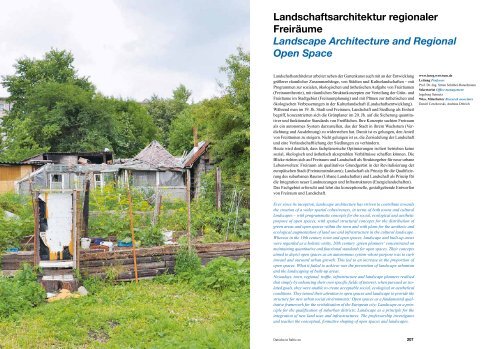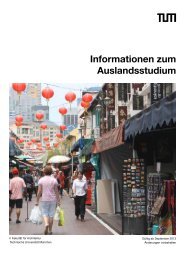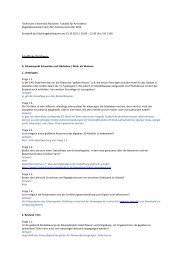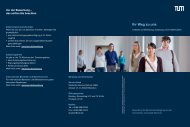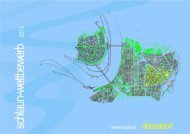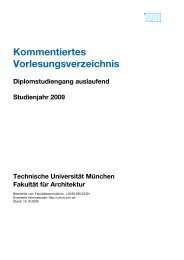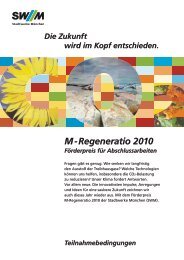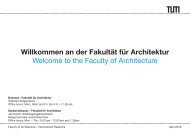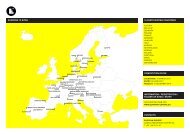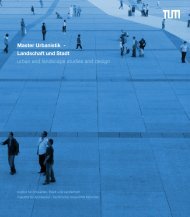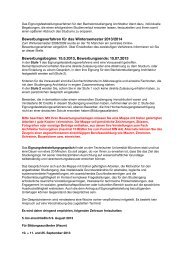Institute Institutes - Fakultät für Architektur - TUM
Institute Institutes - Fakultät für Architektur - TUM
Institute Institutes - Fakultät für Architektur - TUM
Erfolgreiche ePaper selbst erstellen
Machen Sie aus Ihren PDF Publikationen ein blätterbares Flipbook mit unserer einzigartigen Google optimierten e-Paper Software.
Landschaftsarchitektur regionaler<br />
Freiräume<br />
Landscape Architecture and Regional<br />
Open Space<br />
Landschaftsarchitektur arbeitet neben der Gartenkunst auch mit an der Entwicklung<br />
größerer räumlicher Zusammenhänge, von Städten und Kulturlandschaften – mit<br />
Programmen zur sozialen, ökologischen und ästhetischen Aufgabe von Freiräumen<br />
(Freiraumtheorie), mit räumlichen Strukturkonzepten zur Verteilung der Grün- und<br />
Freiräume im Stadtgebiet (Freiraumplanung) und mit Plänen zur ästhetischen und<br />
ökologischen Verbesserungen in der Kulturlandschaft (Landschaftsentwicklung).<br />
Während man im 19. Jh. Stadt und Freiraum, Landschaft und Siedlung als Einheit<br />
begriff, konzentrierten sich die Grünplaner im 20. Jh. auf die Sicherung quantitativer<br />
und funktionaler Standards von Freiflächen. Ihre Konzepte suchten Freiraum<br />
als ein autonomes System darzustellen, das der Stadt in ihrem Wachstum (Verdichtung<br />
und Ausdehnung) zu widerstehen hat. Damit ist es gelungen, den Anteil<br />
von Freiräumen zu steigern. Nicht gelungen ist es, die Zersiedelung der Landschaft<br />
und eine Verlandschaftlichung der Siedlungen zu verhindern.<br />
Heute wird deutlich, dass fachplanerische Optimierungen isoliert betrieben keine<br />
sozial, ökologisch und ästhetisch akzeptablen Verhältnisse schaffen können. Die<br />
Blicke richten sich auf Freiraum und Landschaft als Strukturgeber <strong>für</strong> neue urbane<br />
Lebenswelten: Freiraum als qualitatives Grundgerüst in der Revitalisierung der<br />
europäischen Stadt (Freiraumstrukturen); Landschaft als Prinzip <strong>für</strong> die Qualifizierung<br />
des suburbanen Raums (Urbane Landschaften) und Landschaft als Prinzip <strong>für</strong><br />
die Integration neuer Landnutzungen und Infrastrukturen (Energielandschaften).<br />
Das Fachgebiet erforscht und lehrt das konzeptionelle, gestaltgebende Entwerfen<br />
von Freiraum und Landschaft.<br />
Ever since its inception, landscape architecture has striven to contribute towards<br />
the creation of a wider spatial cohesiveness, in terms of both towns and cultural<br />
landscapes – with programmatic concepts for the social, ecological and aesthetic<br />
purpose of open spaces, with spatial structural concepts for the distribution of<br />
green areas and open spaces within the town and with plans for the aesthetic and<br />
ecological augmentation of land use and infrastructure in the cultural landscape.<br />
Whereas in the 19th century town and open spaces, landscape and built-up areas<br />
were regarded as a holistic entity, 20th century ‚green planners‘ concentrated on<br />
maintaining quantitative and functional standards for open spaces. Their concepts<br />
aimed to depict open spaces as an autonomous system whose purpose was to curb<br />
inward and outward urban growth. This led to an increase in the proportion of<br />
open spaces. What it failed to achieve was the prevention of landscape urbanism<br />
and the landscaping of built-up areas.<br />
Nowadays, town, regional, traffic, infrastructure and landscape planners realised<br />
that simply by enhancing their own specific fields of interest, when pursued as isolated<br />
goals, they were unable to create acceptable social, ecological or aesthetical<br />
conditions. They turned their attention to open spaces and landscape to provide the<br />
structure for new urban social environments: Open spaces as a fundamental qualitative<br />
framework for the revitalisation of the European city; Landscape as a principle<br />
for the qualification of suburban districts; Landscape as a principle for the<br />
integration of new land uses and infrastructures. The professorship investigates<br />
and teaches the conceptual, formative shaping of open spaces and landscapes.<br />
206 Datscha in baltic.eu<br />
207<br />
www.lareg.wzw.tum.de<br />
Leitung Professor<br />
Prof. Dr.-Ing. Sören Schöbel-Rutschmann<br />
Sekretariat Office management<br />
Ingeborg Seimetz<br />
Wiss. Mitarbeiter Research associates<br />
Daniel Czechowski, Andreas Dittrich


